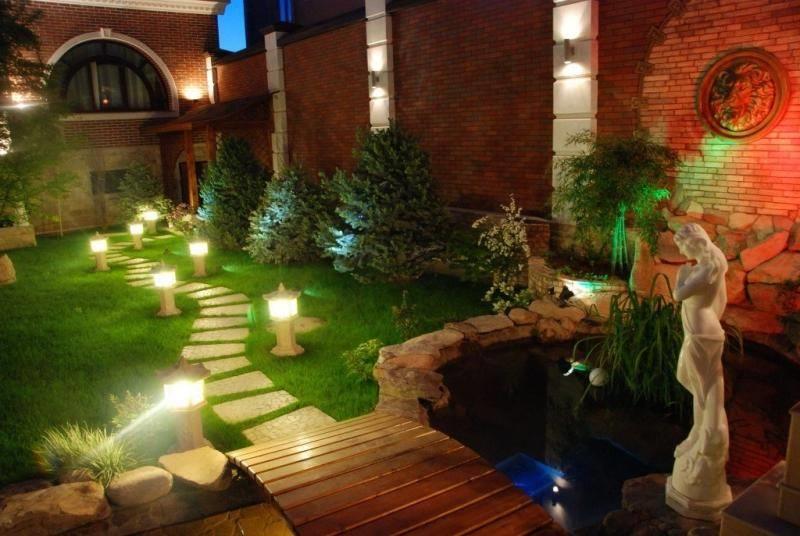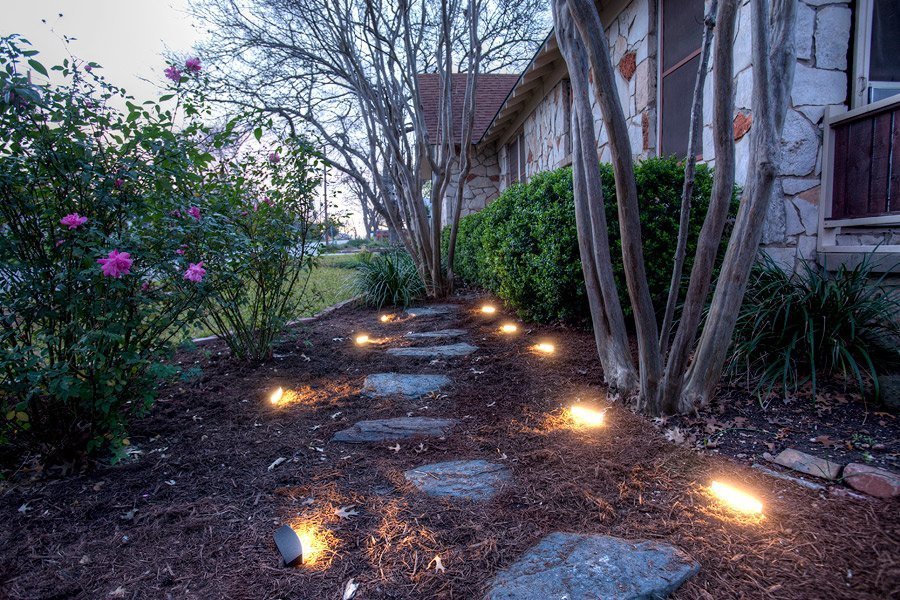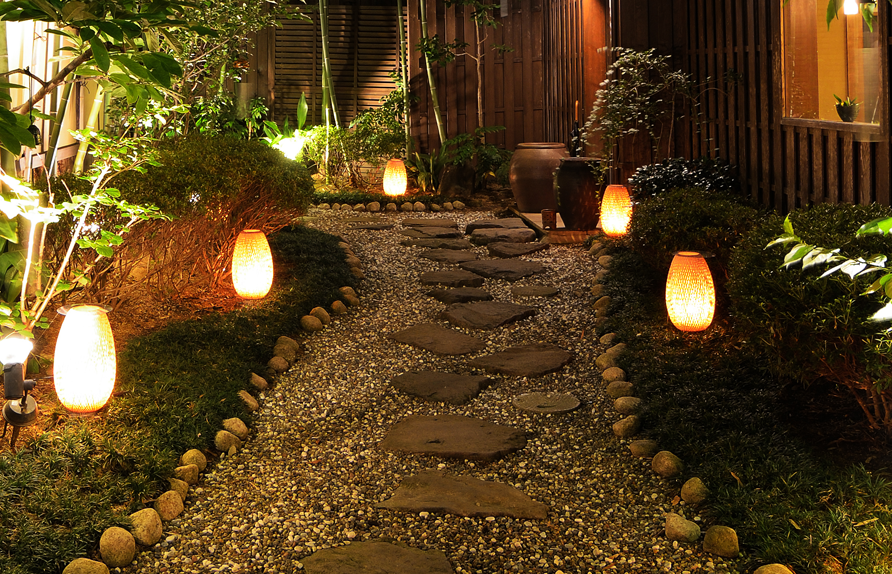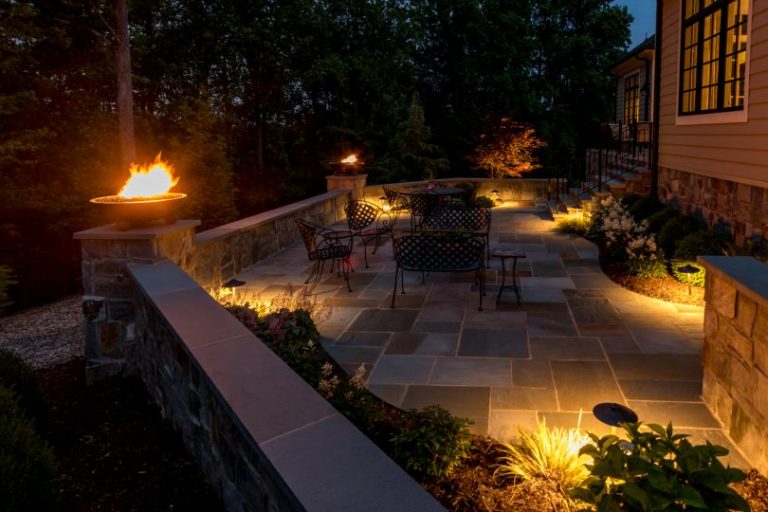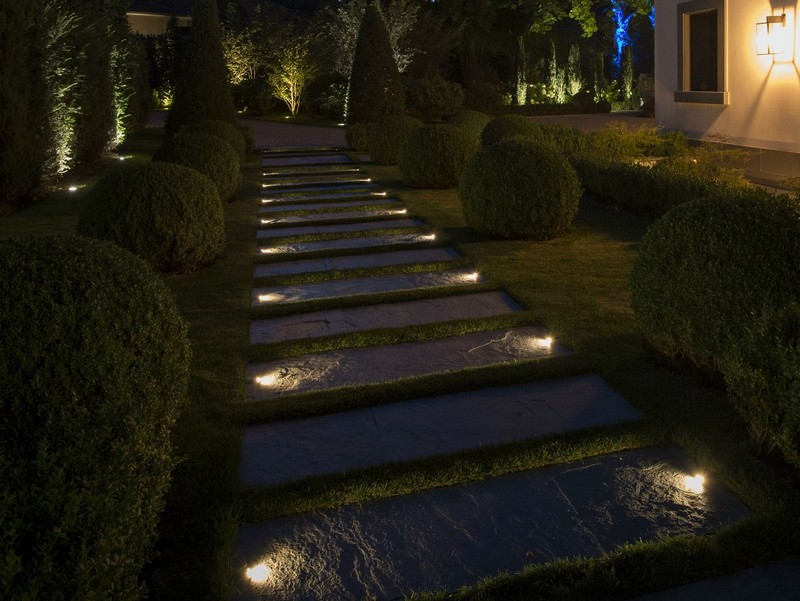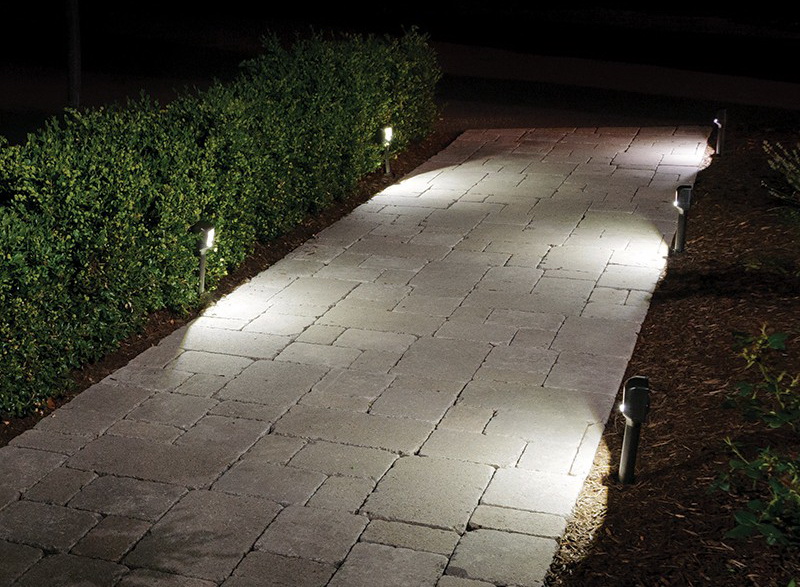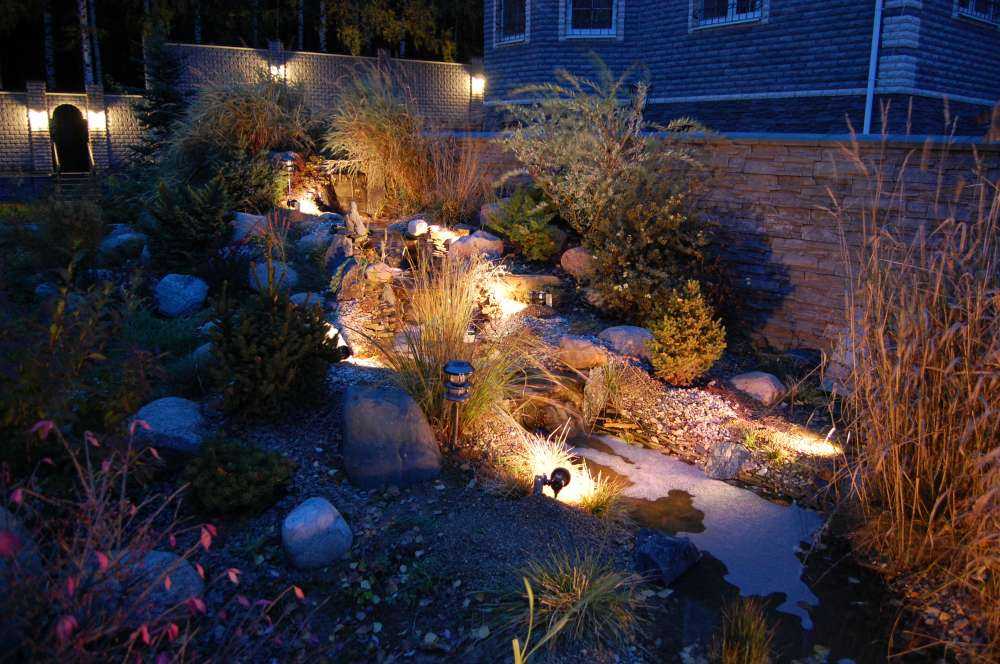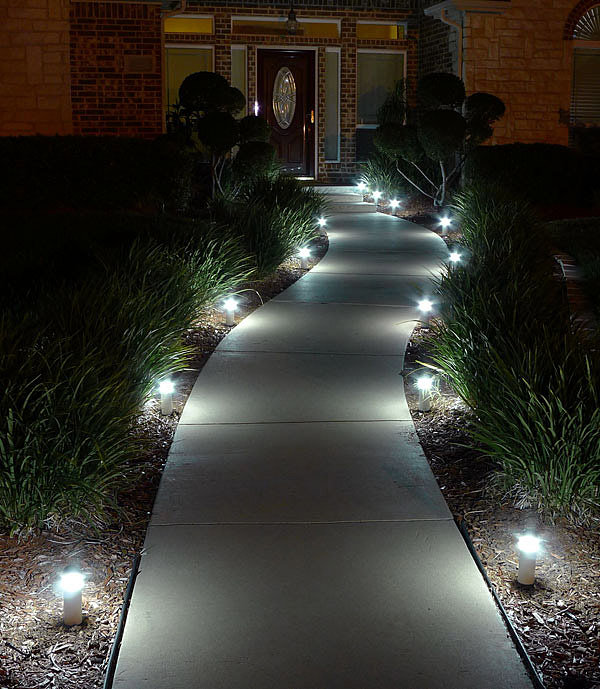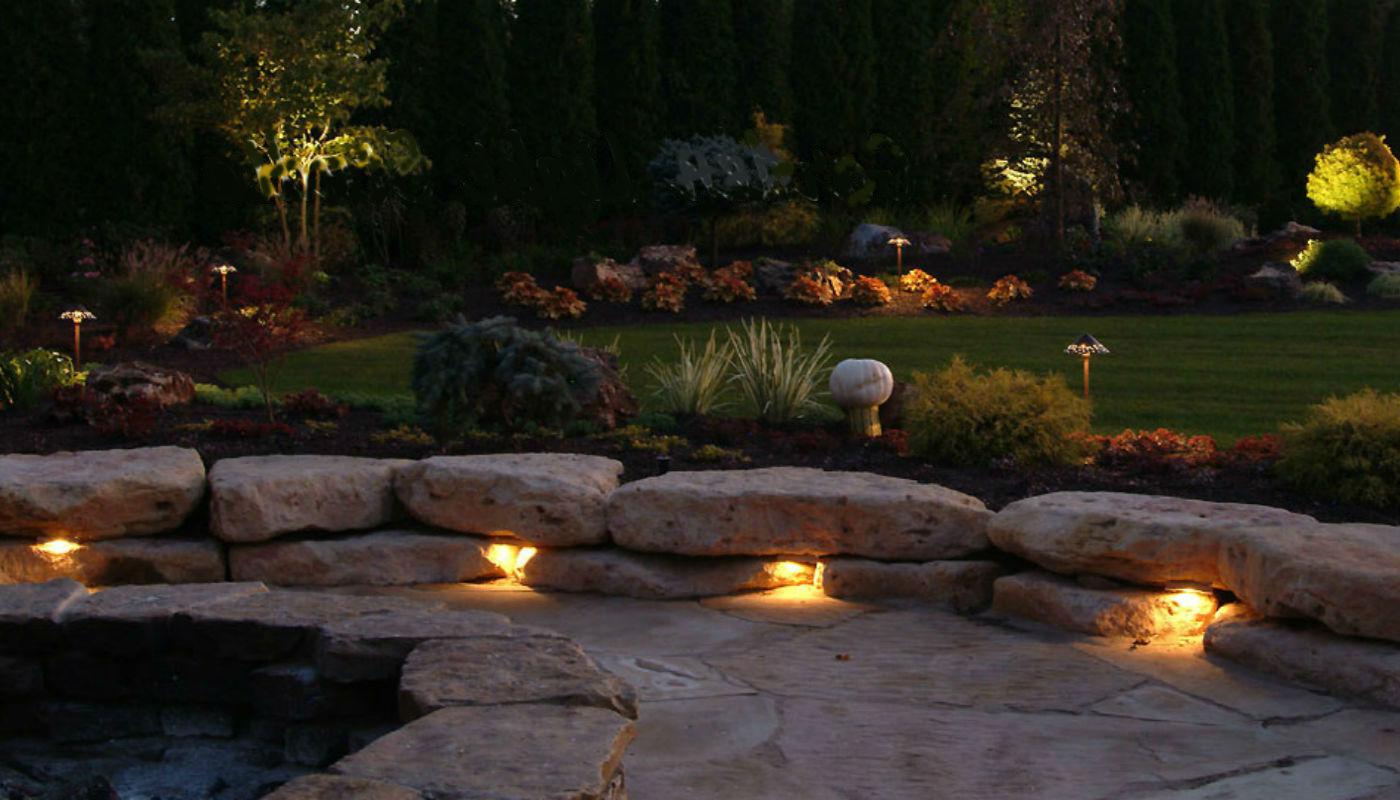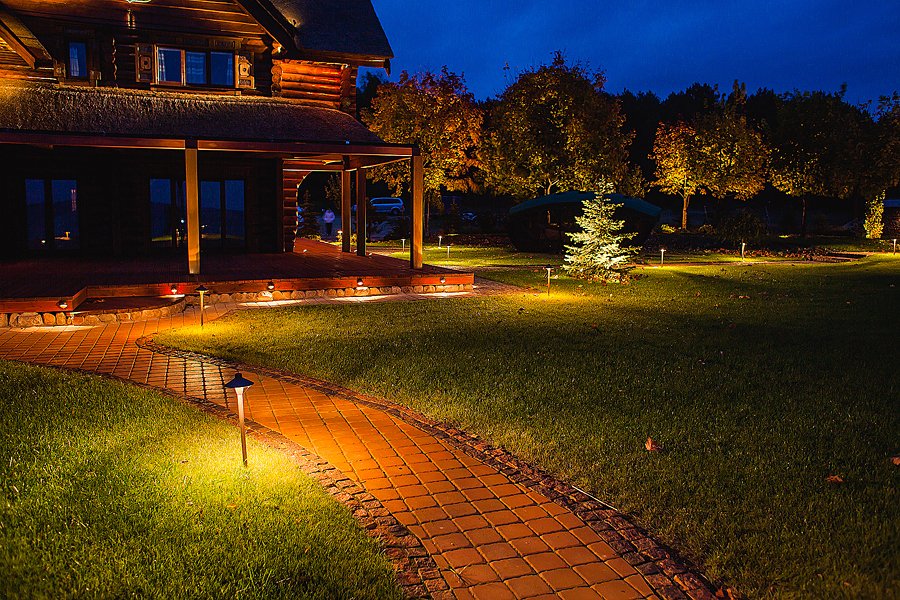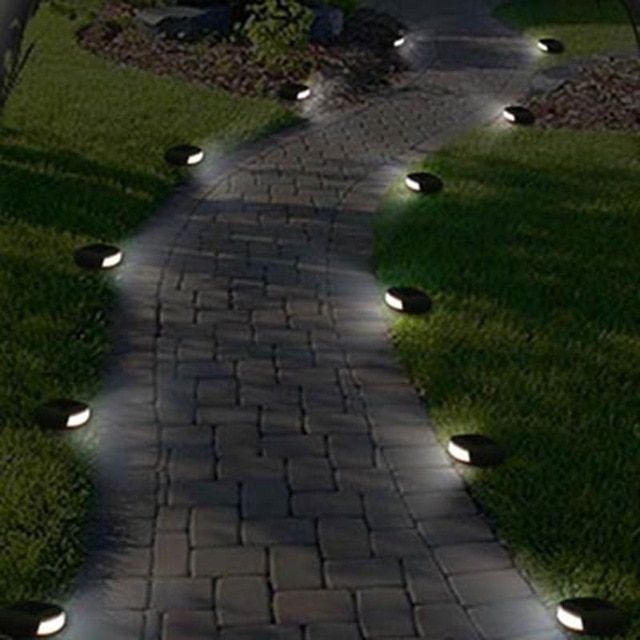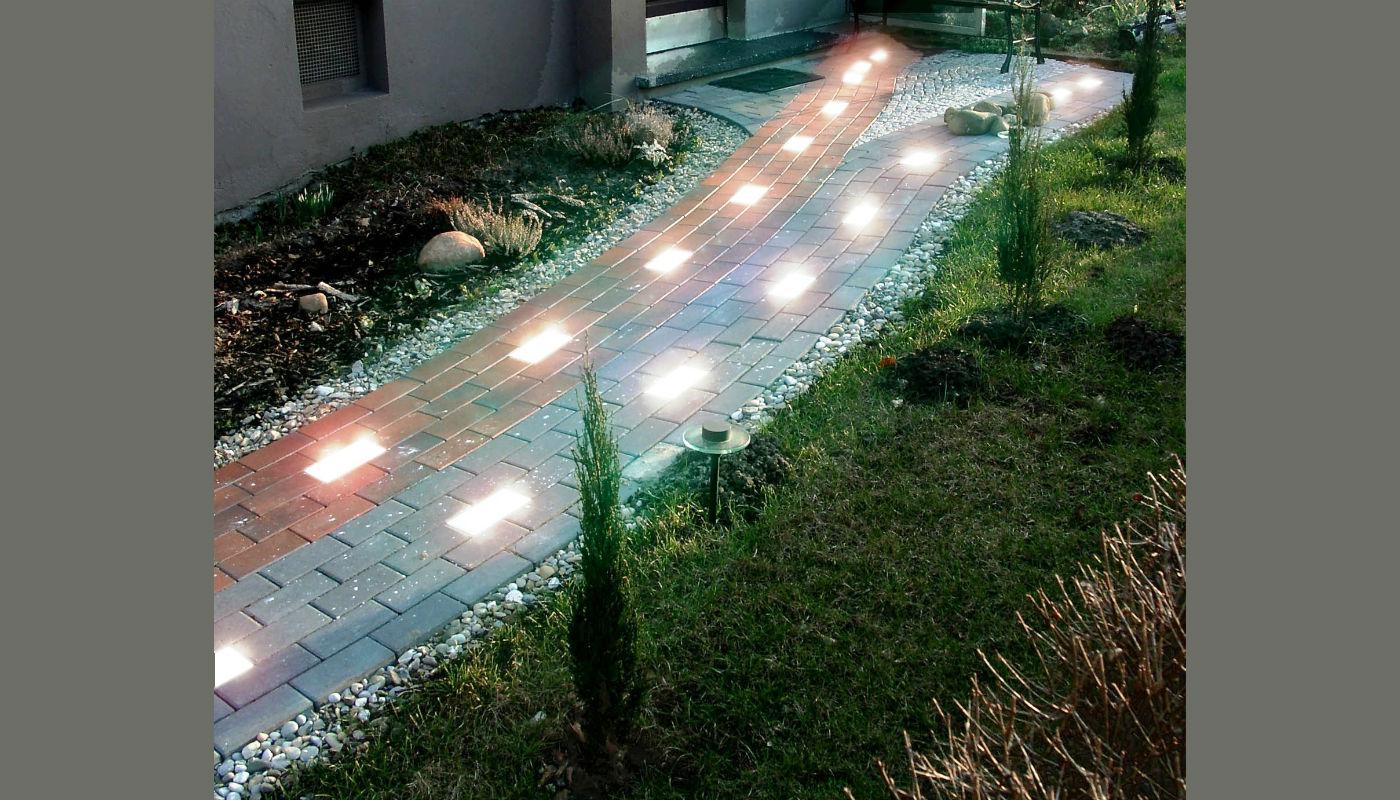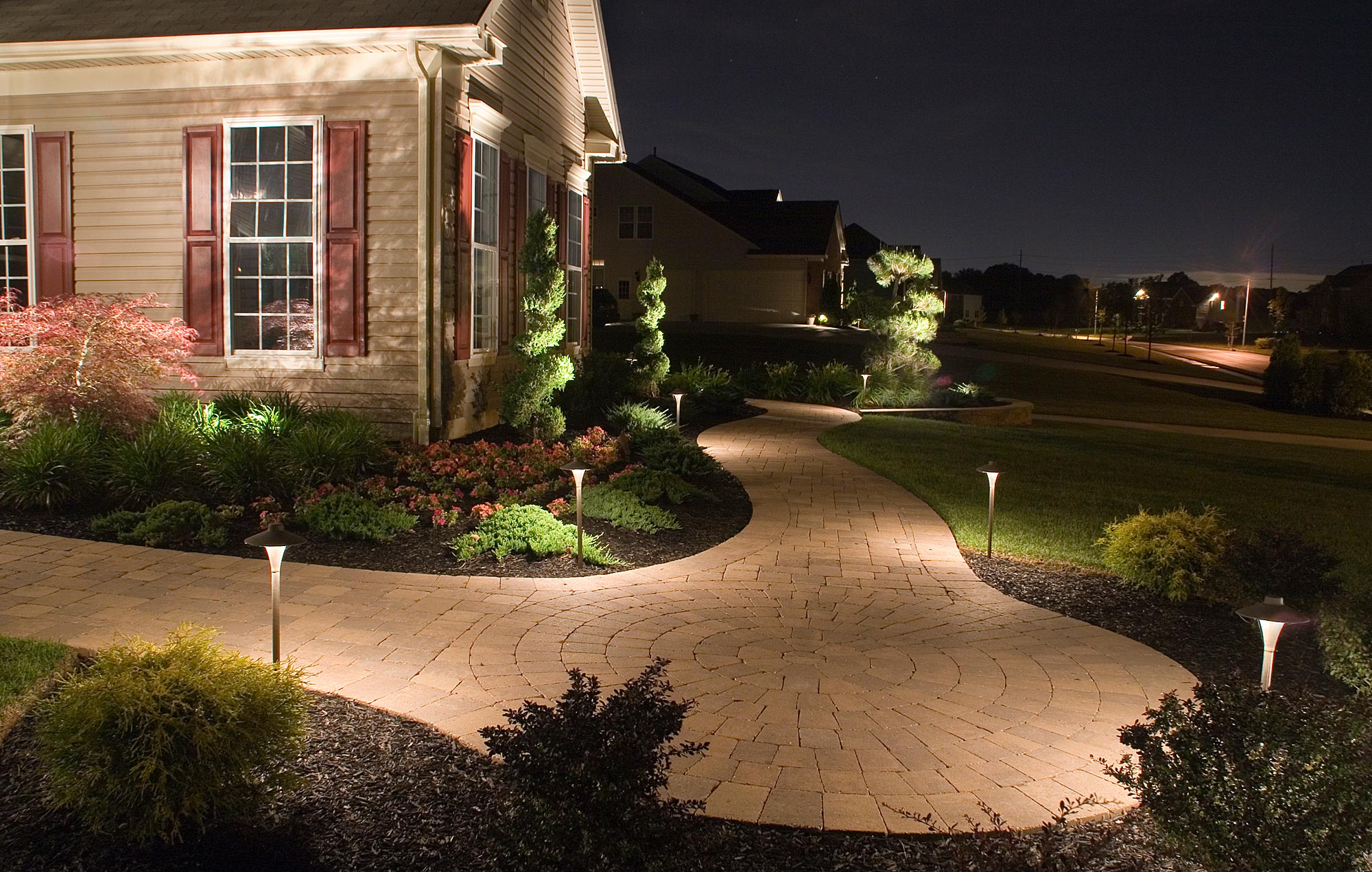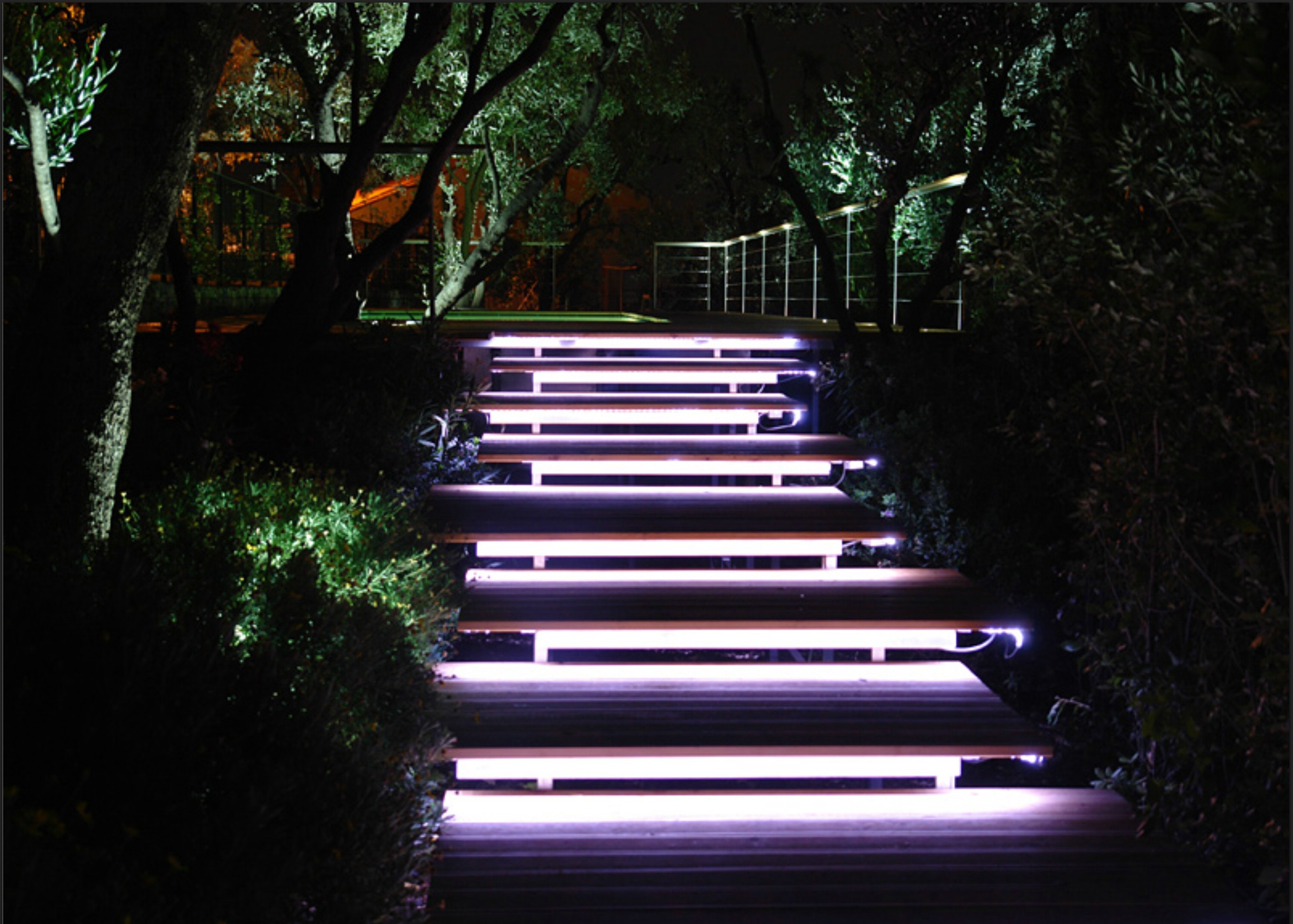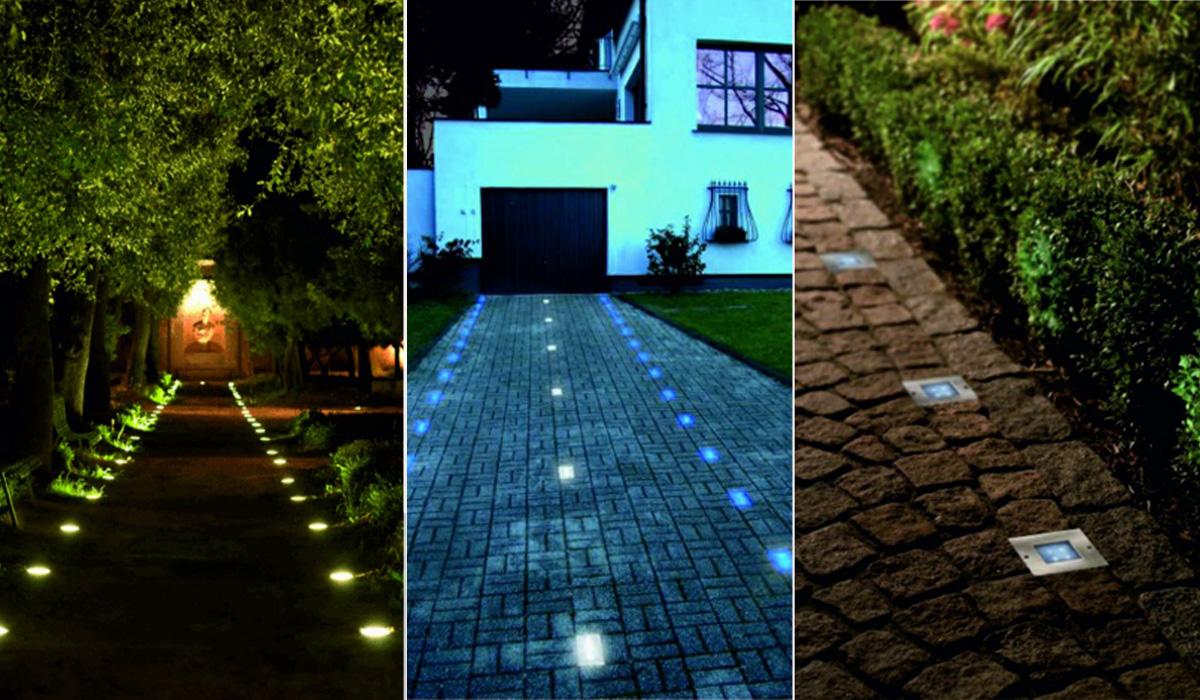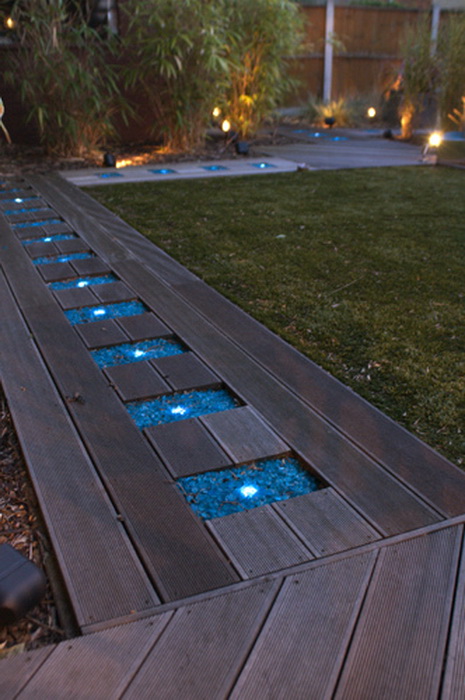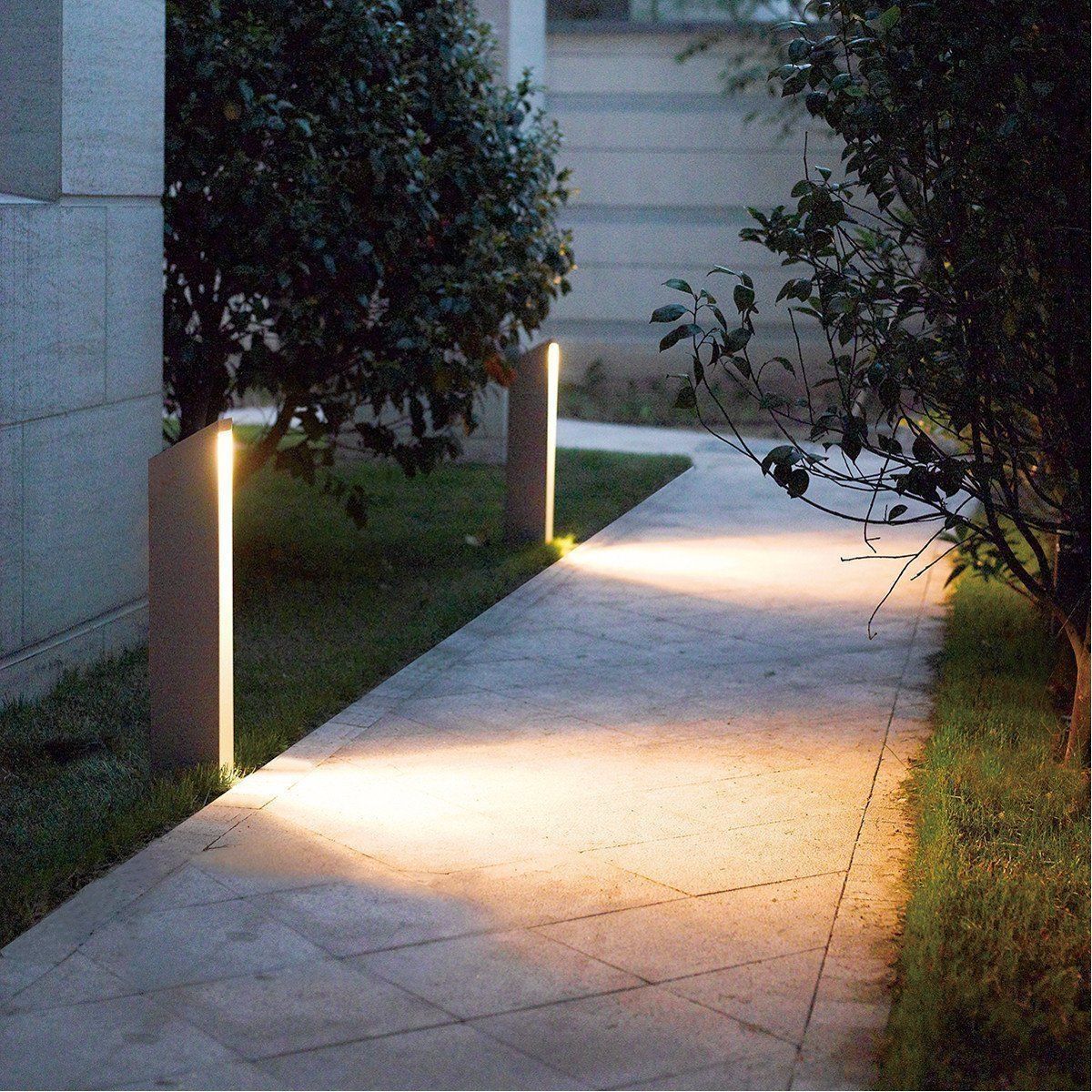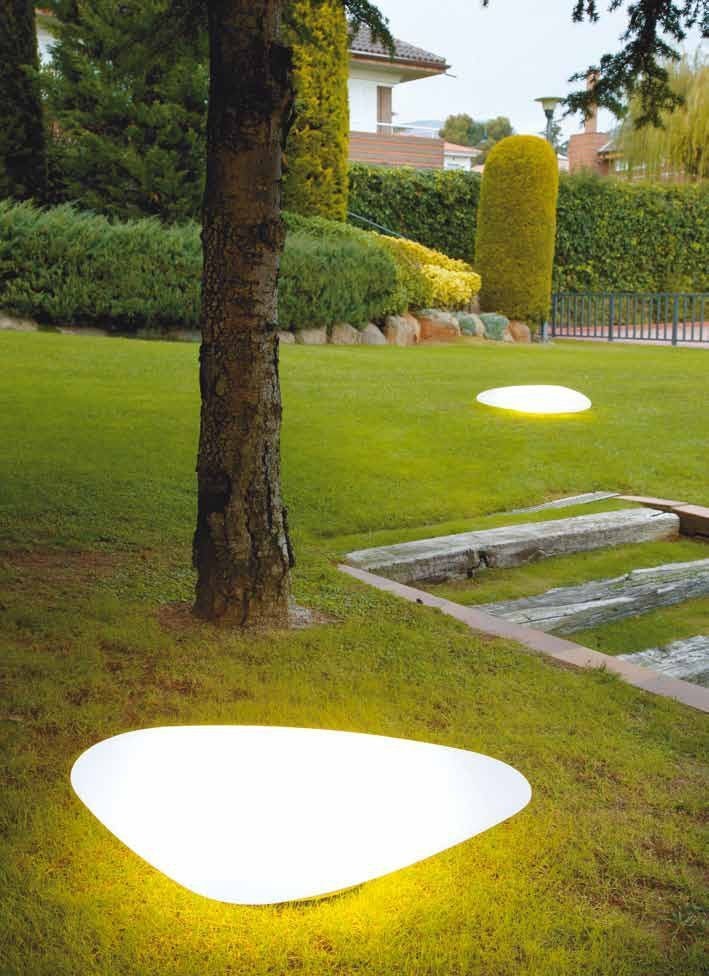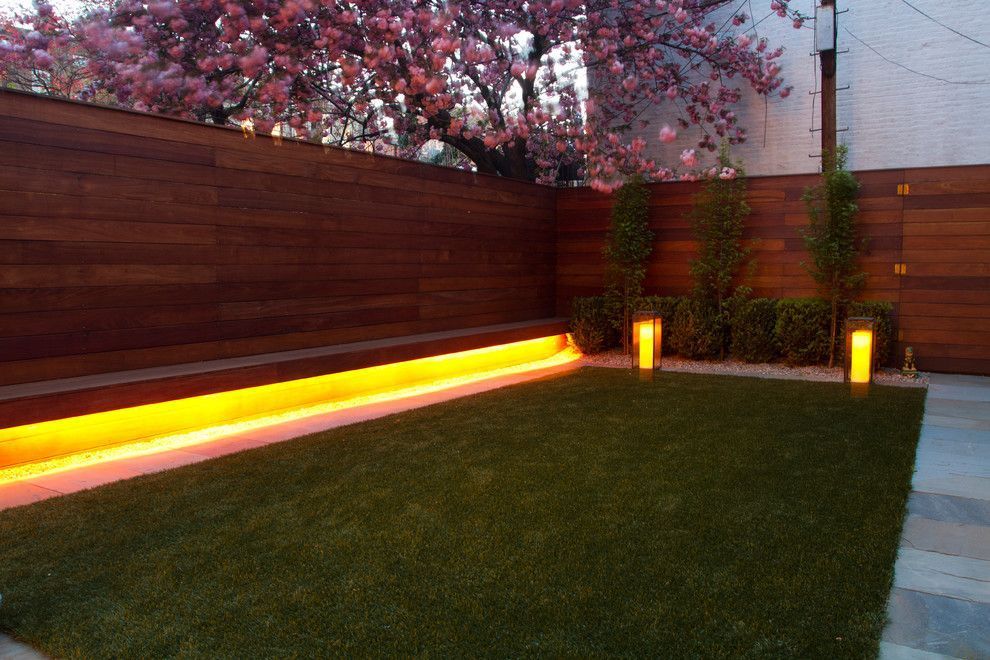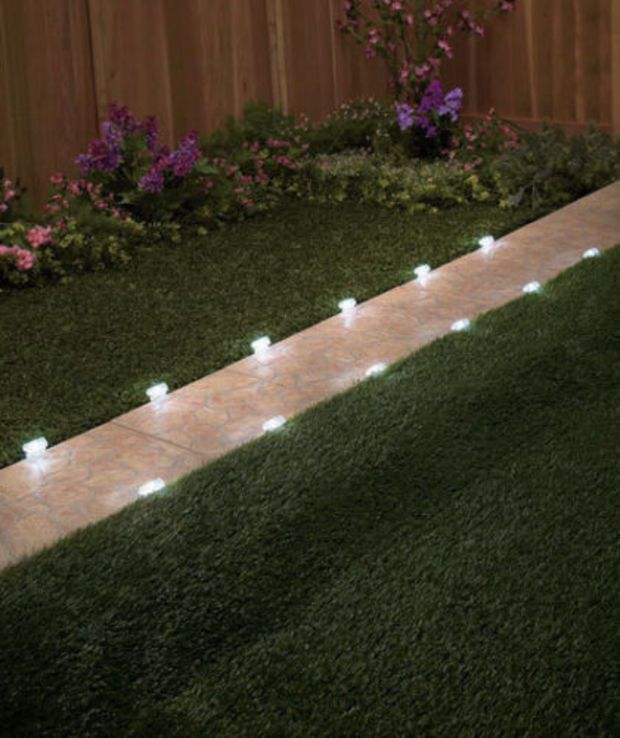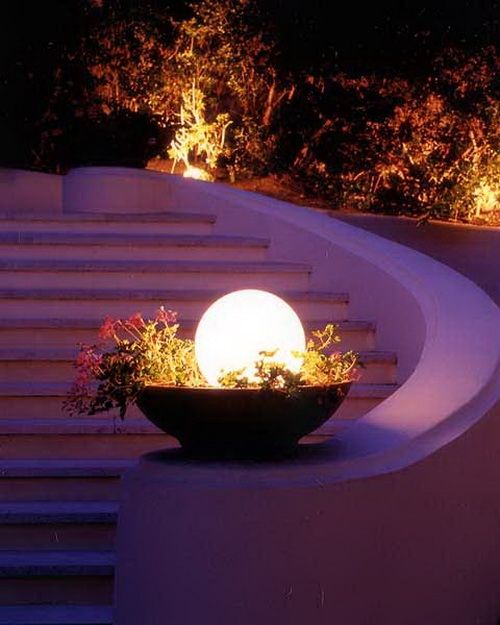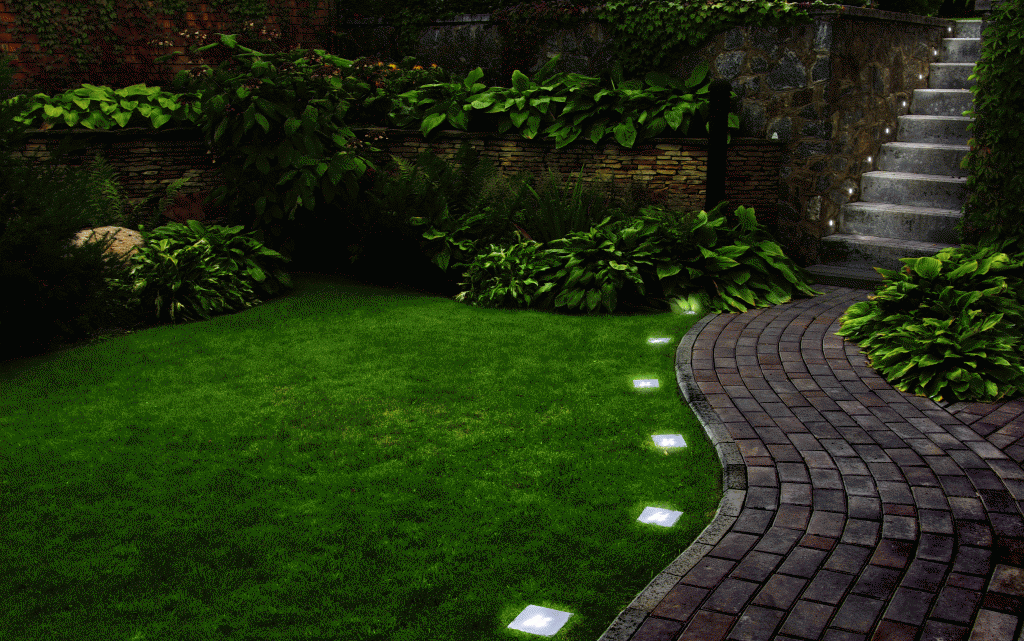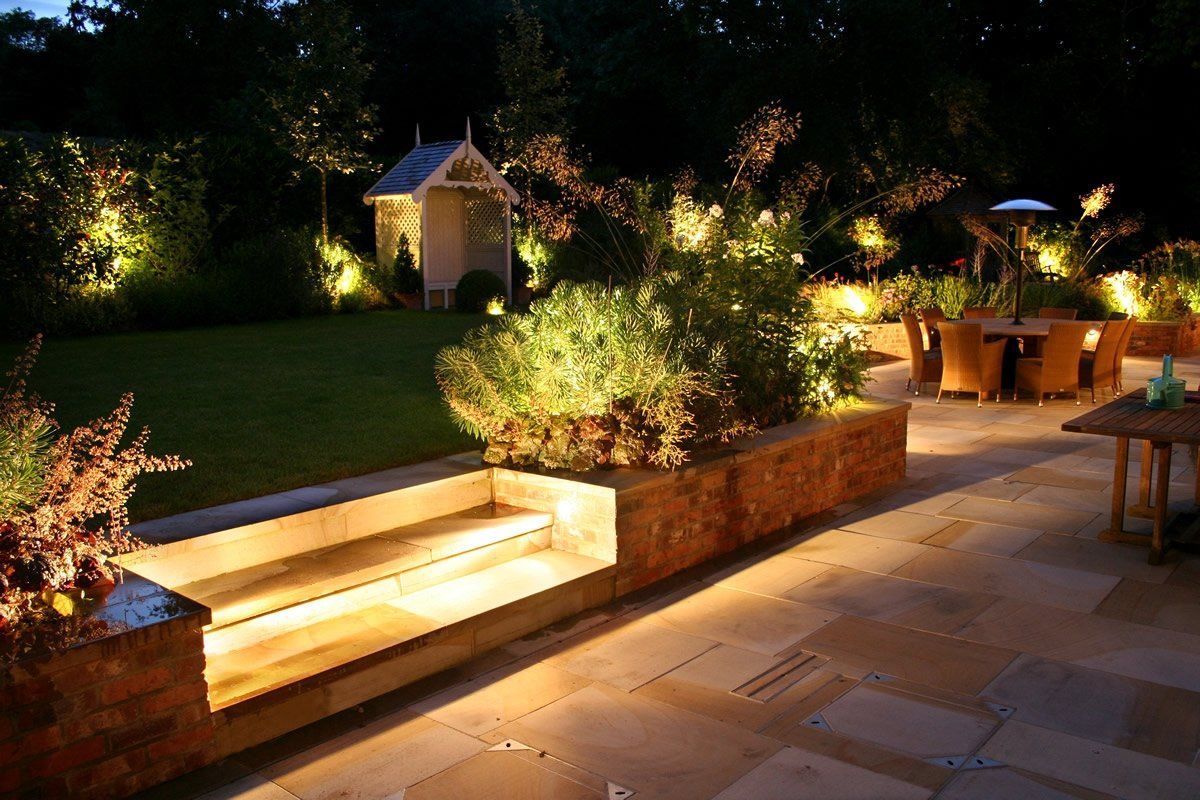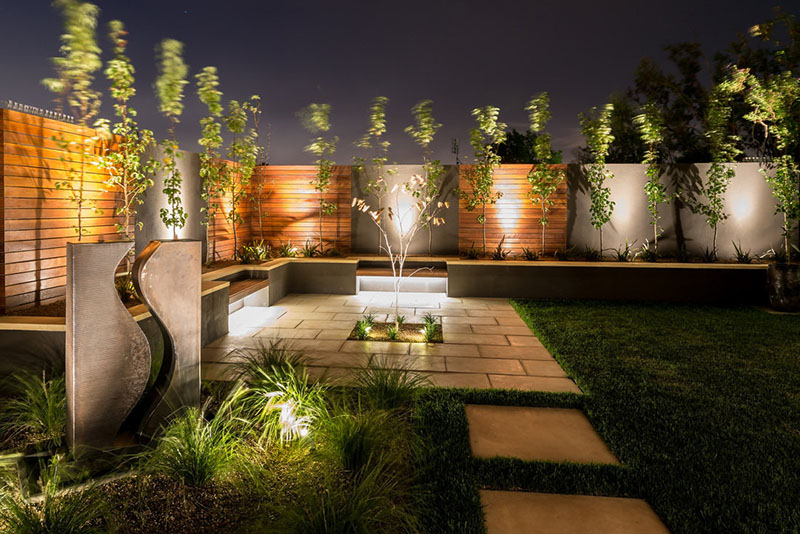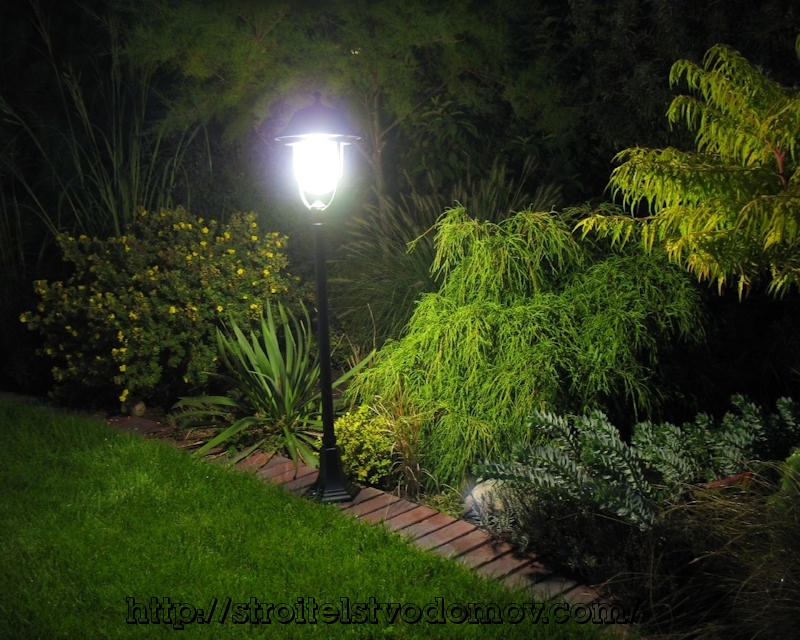Choosing a place to install lamps
The installation location of outdoor luminaires varies depending on the role and size to be performed.
Choosing a place for the lanterns for their intended purpose
- For safety, the best option would be to install lighting along the garden paths, at the entrance to the site, to illuminate the gate and gates, and also to install external lighting of the estate at the entrance to the house.
- For a comfortable stay in the evening, install the lamps directly near the gazebo, on the playground, in the recreation area, near the garden swing, etc.
- To improve the lighting design of the site, install lights near benches, around artificial ponds or a pool, as well as in other places of landscape design. The lighting of the building facades can be placed in various places by installing recessed and floor lamps on the steps.
Choosing a place on the garden path according to the height of the lamp
When installing lighting, it is necessary to take into account the height of the path lighting columns themselves:
- Tall garden lights (from 1.5 m) look beautiful on large estates with wide paths. Lanterns with forging elements look especially original.
- Lanterns-posts for illumination of medium-sized garden paths have a height of up to 1.5 m. This line is favorably distinguished by the fact that many models have bulbs built directly into the posts. These lights will work well in small areas along the pedestrian zone.
- Low bollards are usually installed at the very bottom near the ground or any other covering. The maximum height of such lighting devices is 0.7 m. The lanterns installed in a row will not only illuminate your path in the dark, but also emphasize all forms of paths on the site.
Decorative Garden Lighting - Useful Tips
There are many ways you can create a unique landscape for your garden. You can make original lamps with your own hands or purchase lighting fixtures of an unusual design. We recommend that you listen to some tips for decorating your infield:
Divide the spacious garden plot into zones with the help of lighting.
For recreation areas (playgrounds, gazebos, outdoor terraces, etc.), soft diffused light of warm colors is suitable. Such subdued lighting will create a pleasant atmosphere and will be conducive to communication and pleasant pastime.
If you use lamps of different colors in lighting, then they should definitely complement each other.
It is advisable to use only 2-3 colors.
Be wary of a very bright, white color, as it can “take the life” of your site. Red and brown also need to be used very carefully.
Festive lighting in the garden can be created using garlands, as well as LED lamps placed around the patio perimeter, in the gazebo and hanging from the trees.
What kind of fixtures to use?
The choice of the light source depends on the required illumination power, weather and seasonal conditions under which the luminaire will be used, and the preferred color mode of its operation (dim, natural or bright). Classification of luminaires according to the principle of operation:
Recent Entries
Beautiful but poisonous plants that should not be planted in the garden if you have children and animals Similar to cotton candy: varieties of astilba, from which you can make a beautiful hedge
- Incandescent lamps. The light output of such a source is only 15lm / W, and it will last only a thousand hours.
- Halogen bulbs last twice as long as incandescent bulbs with little difference in light output.
- Metal halide lamps. Light output - 100lm / W. Service life - 12 thousand hours. These lamps create light that is close to natural light, but they get very hot, so they should not be placed next to plants.
- Fluorescent lamps need a waterproof housing. Large lamps with such lamps are difficult to operate, and at temperatures below 5 ° C they often fail. These lamps emit light reminiscent of the moon. Light output - 80lm / W with a service life of up to 15 thousand hours.
- Sodium lamps give a bright orange-yellow light. They have a record light output of 150-200lm / W and a service life of up to 28.5 thousand hours.
- LEDs. The light they emit depends on the type of crystal. Light output - 160lm / W, service life - up to 34 years.
Classification according to the principle of creating lighting:
Lanterns or floor lamps are used most often for the main road to the house. They are made in the style of "retro" or "hi-tech"
It is important that the light source is below the person's gaze, does not blind him and does not interfere with the perception of the surrounding landscape.
Marking lighting. Lamps of the "bollard" or "light column" type do not so much illuminate the space as indicate the direction of movement
They are more often used on secondary tracks.
Luminous paving stones. LED tiles are used in the paving process together with paving slabs or paving stones. It perfectly performs the function of a backlight.
Solar powered devices. These mobile devices come in a variety of designs and are used for decorative purposes. Their batteries are charged by the sun, and at night they automatically turn on LEDs that work until the morning.
If the lighting of the paths in the country house will be organized not only on the basis of devices with solar panels, its system should be developed at the initial stage of the implementation of the landscape project. Imprudence may incur additional costs.

Tile-mounted LEDs illuminate the paths perfectly, but they need special care
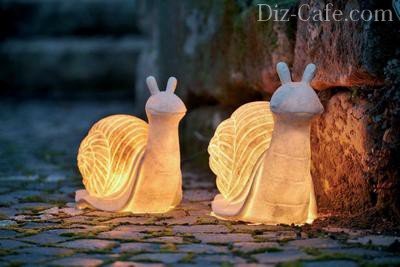
Solar-powered snails are a decoration of any path, but such models of lamps still need to be looked for
Choosing lamps for a summer residence
There are several criteria by which to distinguish between lamps for garden paths. To quickly understand all this variety and find the best solution, check out the most popular options and their distinctive properties.
Types of luminaires by mode of action
- Incandescent lamps. The lamp can be used for thousands of hours, and the light output from the light source is only 15 lm / W.
- Halogen lamps. The devices work 2 times longer than incandescent lamps, with a small difference in light output.
- Fluorescent lamps. Such lighting for pedestrian paths must be used by placing the devices inside a waterproof case. Volumetric luminaires with fluorescent lamps are difficult to operate, and at temperatures below 5C they often stop working, failing. Fluorescent lamps emit light as close as possible to the moon. The service life of the light source is 15,000 hours with a light output of 80 lm / W.
- Metal halide lamps. Creates lighting that is as close to natural as possible. The light output is 100 lm / W, and the service life is 12,000 hours. The disadvantage of a metal halide lamp is that it gets very hot, so they cannot be used or placed next to plants.
- Sodium lamps. They have a record light output of 150-200 lm / W, and a service life of approximately 29,000 hours. Sodium lamps give off a bright yellow-orange light.
- LEDs. Lighting service life - up to 34 years with a light output of 160 lm / W. The emitted light color depends on the type and size of the crystal used in the LED.
Types of luminaires by light output and design
- Floor lamps or lanterns for lighting paths - they are installed vertically and have built-in frosted glass diffusers. This type of lighting is most often used to brighten the main road to the house. Experts recommend choosing such a distance between the lights so that the lighting radii do not intersect. Floor lamps in the “retro” or “high-tech” style are quite popular.
- Marking lighting. A “light bollard” or “bollard” luminaire is intended not so much to illuminate the entire space, but to indicate the direction of movement. That is, a winning solution would be to install such luminaires to create lighting along the secondary paths.
- Luminous paving stones perfectly serve as a backlight. To do this, in the process of paving paving slabs or paving stones, place LED tiles.
- Decorative lighting in the form of LED bulbs in the form of a variety of decorative garden lanterns or in garden figurines. Such an artistic approach will significantly embellish the site and focus on small architectural forms.
- Solar powered luminaires. These devices have a variable design and are used more for decoration. The batteries of the devices are charged directly from the sun, and in the evening the LEDs automatically start to shine, which ensure the functioning of the lamps until the morning.
- Spherical lights are an organic sphere shape made of carbonate or polycarbonate. Equipped with low-power lamps, spherical lamps are able to create dim mysterious illumination of the path in the country, decorating the landscape design of the garden.
Useful Tips
- Before starting work, develop a project for the placement of all street lights and fixtures.
- Do not use fluorescent lamps at low temperatures, as they will not light up.
- Solar-powered luminaires are best suited for a country house, as they operate on solar energy, but still have a low price. The only drawback is the impossibility of functioning all night, after 4-5 hours the lighting will become dim or go out.
- LED lamps and halogens are ideal for backlighting a house, since they not only give out a sufficiently bright luminous flux, but also have a long-term operation.
- Use motion sensors, as well as an electric photo relay, to set the required time for the backlight to turn on. The modern way of management will reduce energy consumption and your money resources.
- Lay all wires to lighting sources underground so as not to spoil the overall design of the site, as well as to protect them from mechanical damage.
Examples of using
With a large number of glowing stones, you can completely abandon traditional methods of street lighting. Magic stones can be used to decorate the borders of paths, thereby making their outline, illuminating the direction and marking the boundaries of the pedestrian zone.
Idea: small glowing stones (chips) can be used in the process of laying garden paths - just add glowing stones to concrete, thereby creating the effect of a starry sky.
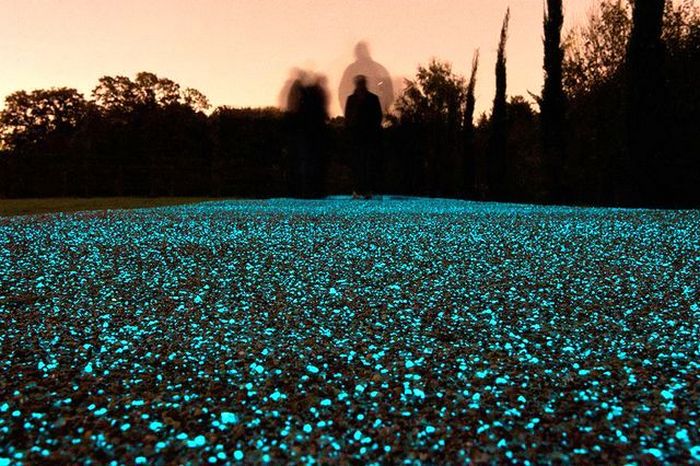
Glowing trail made of crumb
Also on our website: lighting of the summer cottage.
In addition to being used for paths, you can arrange flower beds and flower beds with glowing stones, lay them on the lawn, near large trees. Such lighting will look very harmoniously near pools and ponds, as well as near a recreation area.
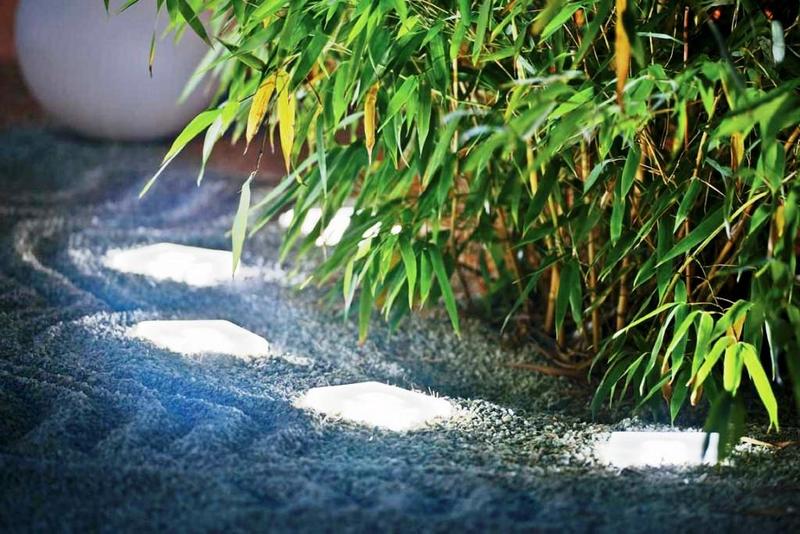
Plant lighting
It is very easy to make paths glowing in the dark in the country with your own hands. The design options for the site using glowing elements are limited only by your imagination. With the help of such original crafts, the territory of the house will be filled with a magical atmosphere and bright colors!
From this video you will learn how to make a phosphor with your own hands.
Correct wiring
Let's consider how to connect the wiring to the fixtures. For this you will need:
- an electric cable of the VVG type with a core thickness of 1.5 mm;
- terminal blocks designed for a current strength of 5–10 A;
- corrugated pipe with a diameter of 18–25 mm.
For massive luminaires on racks, it may be necessary to pre-fill the foundation.
In this case, it is made columnar. The holes are drilled with a brace, sand is poured onto the bottom and tamped. A plastic tube is installed in the center of the wooden formwork, in which the cable will be located in the future. Its ends need to be glued so that the concrete does not get inside. Anchors are inserted into freshly poured concrete for further fastening of the rack. When it hardens, you can start laying the cable.
The wiring process is carried out as follows:
- Dig trenches 70–80 cm deep. The distance to buildings should be at least 60 cm, from pipelines - at least 0.5 m.
- If it is planned to install luminaires on metal supports, the cable must be placed in a corrugated sleeve, then passed through all the racks. The outward residue must be at least 10-15 cm. Pass the second piece of cable through the pipe. At the top of the luminaire, connect it to the first one using the terminals.
- If the lanterns are mounted on a wall, the junction boxes must be carefully insulated. It is best if they are connected with compression nuts.
- Fit the wiring diagram. Check that the switch opens the phase conductor. This can be done using an indicator.
- You can connect the system to a regular outlet or to the terminals on the electrical panel. In any case, check whether the rated capacity of the circuit breaker matches the load of the given network.
Before digging trenches, make sure that all elements are working.
As you can see, there are a large number of ways to decorate a personal plot with decorative lamps. Imagine and experiment, while not forgetting about safety measures, and your garden will turn into a truly magical place.
Varieties: photo and description
Tracks
Trail network lighting features:
- It is recommended to arrange the luminaires so that the entire route is evenly illuminated.
- For short paths without obstacles in the form of steps and bevels, it will be possible to arrange the installation of small light sources. They can be placed just above ground level.
- It is better to illuminate long sections of the path with high lanterns.
- The gaps between the luminaires should not be too large: dark areas should be avoided.
- The backlight can be switched on either manually or using an automatic system controlled by a timer or light sensor.
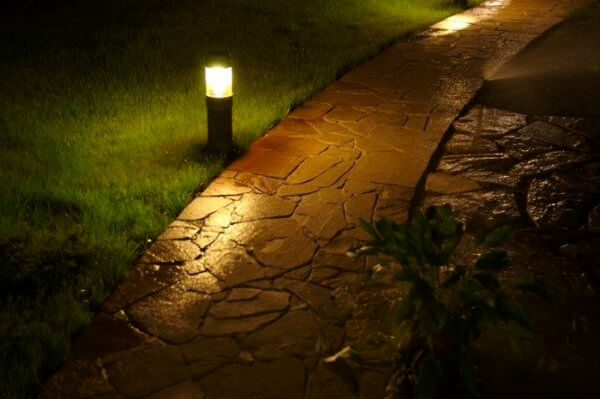
Fence
The level of security will be increased, as the surrounding area will also be illuminated:
- Access roads to the site. Installing a pair of light sources in the entrance area will allow you to observe who is next to your summer cottage.
- The inner perimeter of the courtyard. The backlight will increase the safety of movement around the territory in the evening hours.
- The territory adjacent to the site. In the city, this function is performed by city-wide lighting fixtures, but one cannot count on such amenities outside the city. This disadvantage is easily compensated for by installing street lights on your own. They are mounted on fence posts or on the fence itself, directing the flow of light towards the street.
To decorate the lighting of the fence, two groups of lamps are most often used:
- with a transparent plastic flask;
- more aesthetic glass-finished models.
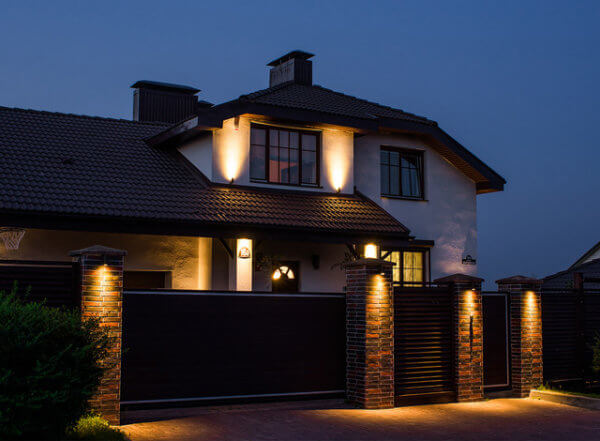
Lighting types
Garden lighting can be divided into several types: technical (functional), decorative, security, and architectural.
If you decide to make garden lighting with your own hands, you need to remember that technical lighting is done at a certain height, but not too high, so as not to disturb the comfort. An example of technical lighting is the lanterns at the gate. The light should fall from top to bottom.
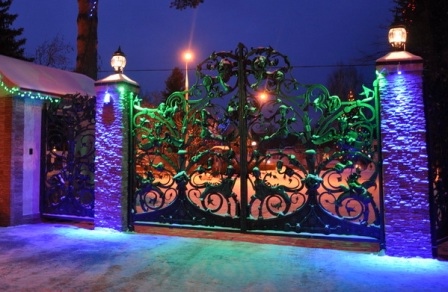
Decorative lighting should highlight the advantages of landscape design and complement it with new colors. This lighting is usually installed in recreation areas, near alpine slides, and reservoirs. After all, just one backlight can completely change the picture of the garden.
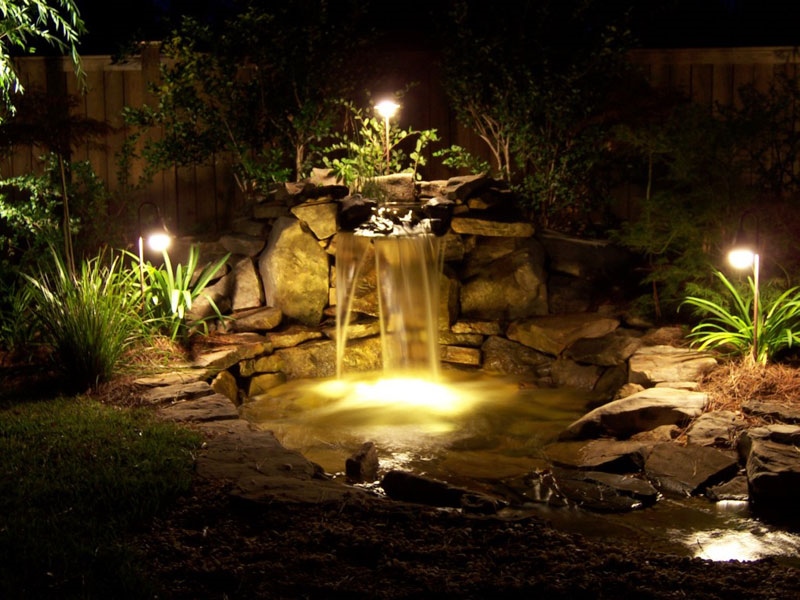
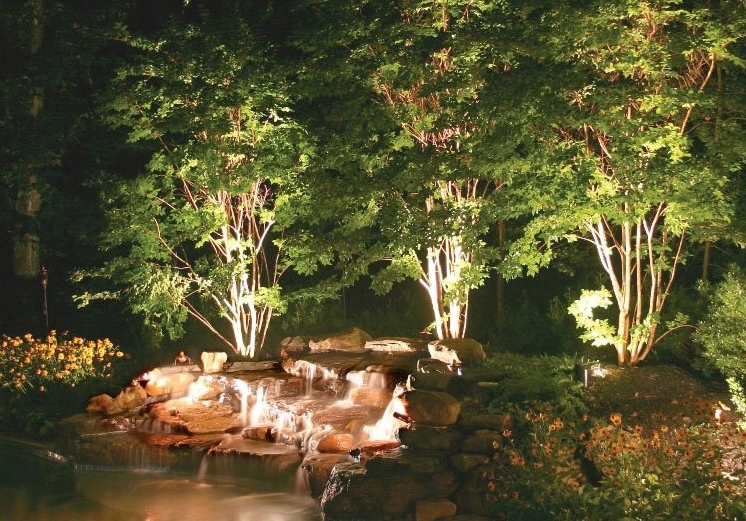
Security lighting serves for protection and creates the effect of the presence of people. This lighting can be divided into 2 types. In the first type, the lighting is automatically turned on in the dark (photocells are used to turn on and off). In the second case, the lighting turns on at the slightest movement (motion sensors are installed here).
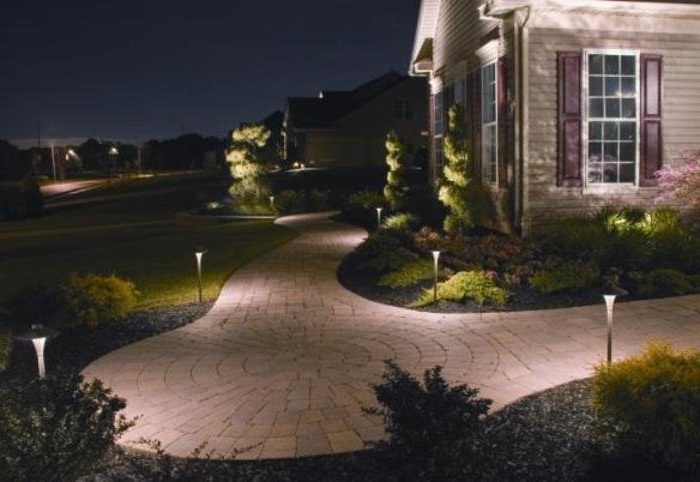
Architectural lighting, as a rule, not only illuminates the house, but also combines technical and decorative functions.
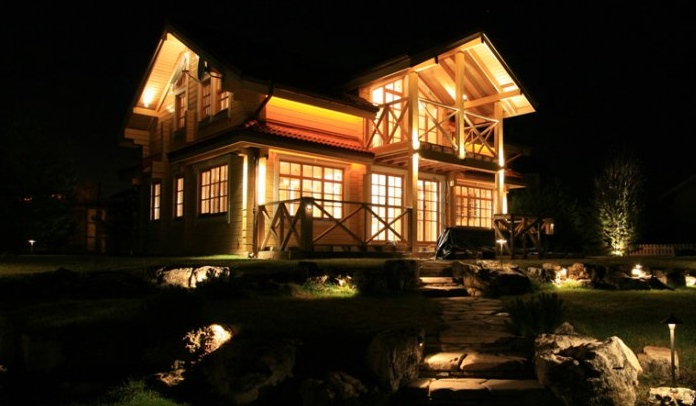
Installation of wiring and switches
Electrical equipment to be installed outdoors must meet strict requirements:
- All cables that run along the walls of the building must be placed inside a corrugation made of non-combustible plastic. Open wiring - have two layers of insulation.
- All wire connections are housed inside communication boxes or boxes in which the wires are connected with clamping nuts. You can make the connection by twisting the wires. Then each twist will need to be well insulated.
- The lamps themselves, sockets and switches must be chosen not only from the point of view of aesthetics, but also from the point of view of safety. All devices must be approved for outdoor use, be leakproof. In extreme cases, it is allowed to install semi-hermetic devices. But they will need additional protection from atmospheric precipitation in the form of visors.
Attention
It is better that the material for the manufacture of sockets, sockets and switches installed outdoors is porcelain. It's safer than plastic
DIY garden lighting - the choice of lamps
The main requirements for street lamps are moisture and frost resistance. Also, luminaires should not be susceptible to rust.
Varieties of lanterns:
Suspended (installed on gazebos, terraces, patios);
Searchlights (directional light);
Wall lamps (illuminate resting places);
Floor (can be both low and high);
Floor-standing (their height is up to 30 cm).
Notes
For decorative purposes, it is not recommended to make lamps taller than 60 cm, otherwise they will cause discomfort.
Solar powered luminaires are well suited for decorative lighting. They do not require electricity supply and can always be rearranged or removed. They are not suitable for lighting due to their low power, but they will be able to mark the edges of the paths well.
Underwater lamps often look effective in a pond.
Before filling a trench with electrical wiring, it is necessary to check the operation of all lamps.
Lighting rules
The light directed upwards will illuminate tall bushes and tree crowns, and downward will illuminate small plants.
The space is well harmonized by not bright and at the same time warm (warm spectrum) lighting.
Each lamp should not only illuminate, but also be decorative during the day.
The right lighting can change the area beyond recognition.
I recommend watching a helpful video with lighting notes below.
Evening garden lighting
And some more beautiful garden lighting photos for you.
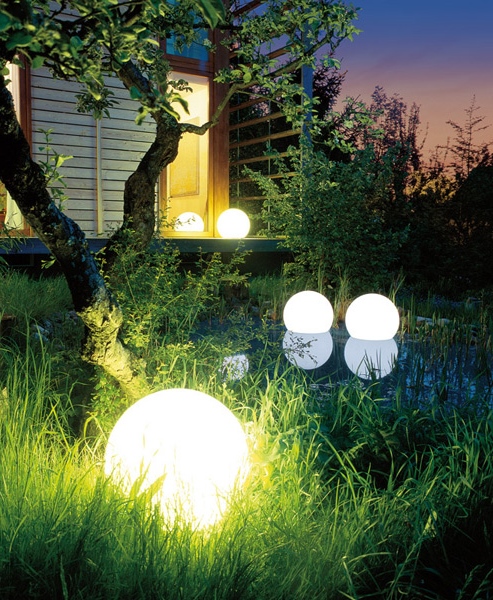
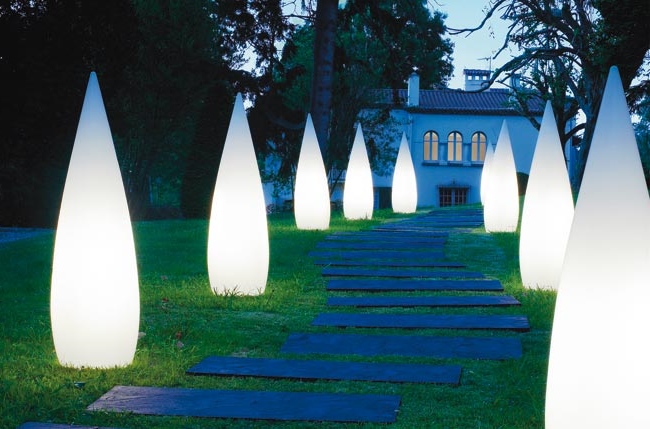
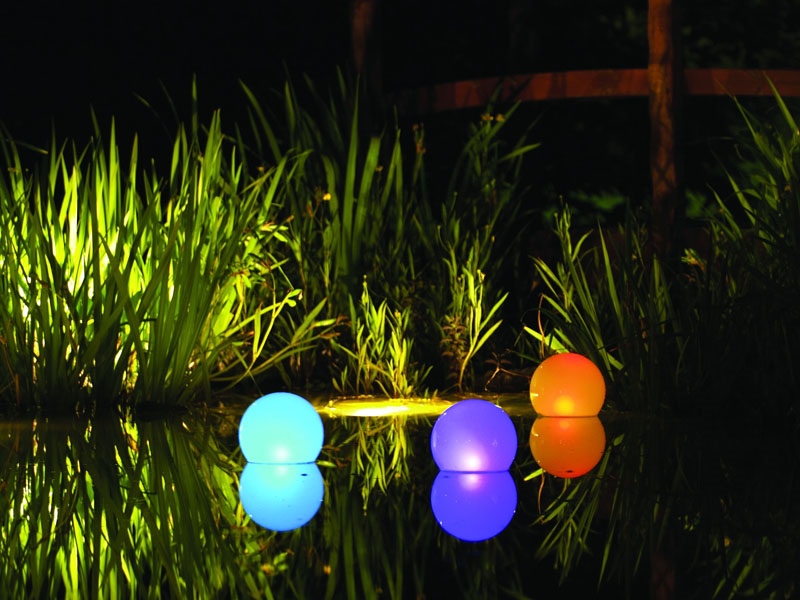
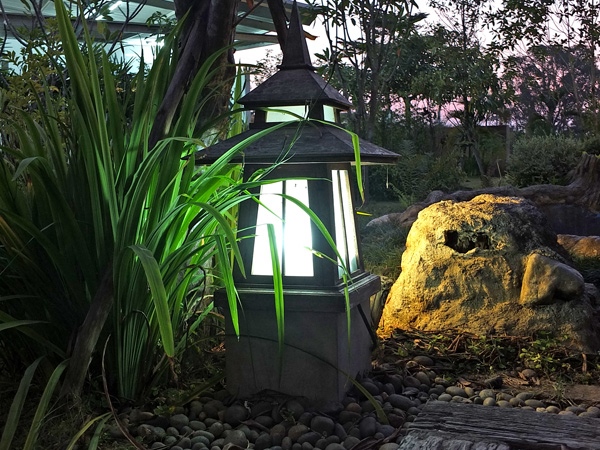




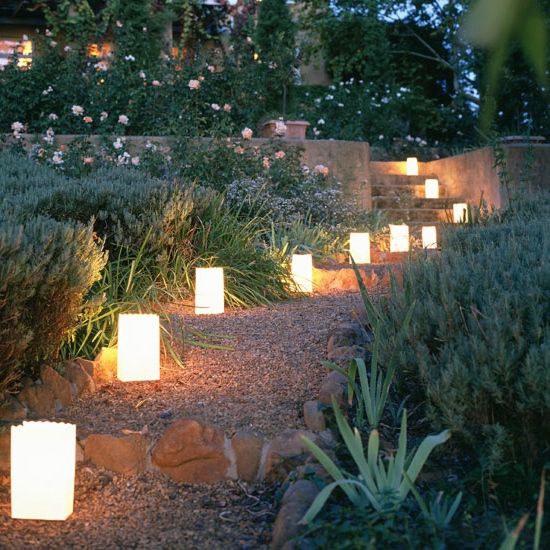
I recommend the following articles as additional materials:
Additional Information
DIY garden lighting
What's the secret to creating the right lighting?
Truly, garden lighting is akin to art - it can create unprecedented effects that are born from the union of plants and decorative lighting. You just need to implement some "educational" ideas for a summer residence - with your own hands you can transform your garden so much that from an inconspicuous, no different from many others, it will turn into a fabulous corner that can touch you at any time of the day.
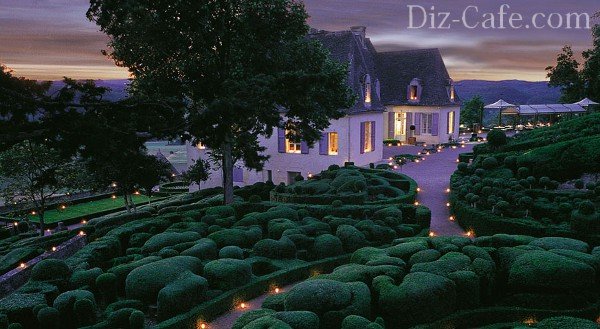
Evening illumination of the summer cottage will not only give the garden some mystery, but also allow you to safely move around the site
Your garden house and country landscape will look natural during the day and mysterious in the evening if you successfully combine the functionality of lighting with its decorative effect. What are the tasks assigned to the lighting of the garden area? Depending on the function and area of placement of outdoor lamps, the following types of summer cottage lighting can be distinguished:
- home lighting;
- illumination of tracks;
- lighting of stairs;
- accent lighting;
- backlit patio;
- festive lighting;
- security lighting.
An important condition for the correct organization of the dacha lighting system is to preserve the aesthetics of the garden in the daytime, that is, lamps for night illumination should not violate the harmony of the dacha landscape. To fulfill this condition, it is enough to choose lighting devices of a natural shape and / or made of natural materials.
A widespread technique for decorative illumination of a garden is glowing stones that absorb solar energy throughout the day and release it at night in the form of a mysterious glow pouring softly, as if from the inside of a rock.
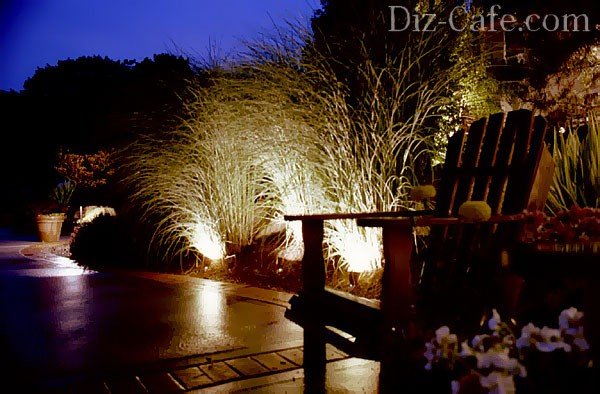
Original lighting, placed in dense vegetation, will create a cozy atmosphere in a secluded recreation area
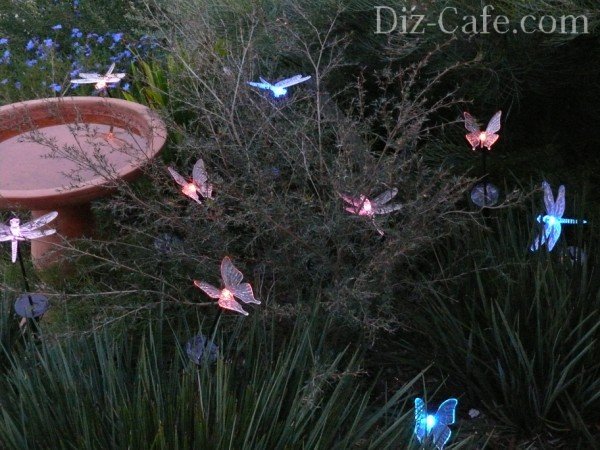
Air butterflies and dragonflies, glowing in the dark, naturally and unobtrusively coexist with garden plants
Or maybe you prefer a group of bright butterflies on long twigs stuck in the ground, which will enliven the lawn during the day and glow at night? And how do you like a gnome looking out from behind a bush with a lamp or a glowing frog nestling under a large leaf? Such original solutions will give your dacha individuality and originality, to the delight of you and the kind envy of your neighbors.
In addition to the artistic impression, it is necessary to think over the technical side of the cottage lighting. The use of alternative light sources based on solar energy is the most economical option for illuminating a garden. In addition, this type of lighting will not spoil the appearance of the site with long electric cords stretching along the flower beds and paths, since it consists of an autonomous battery pack and a group of lamps connected to it.
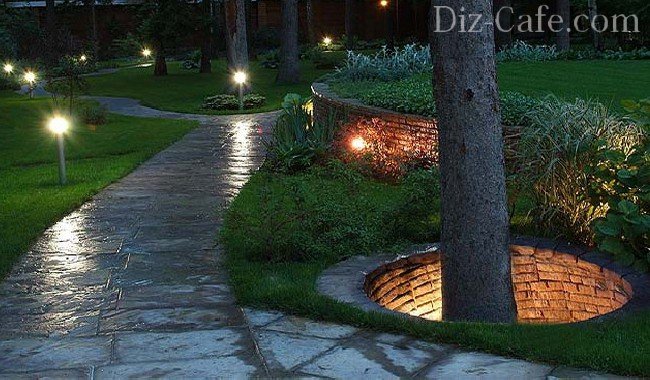
The unusual illumination of trees in the form of glowing wells is so mysterious that you inexorably want to look into this depth.
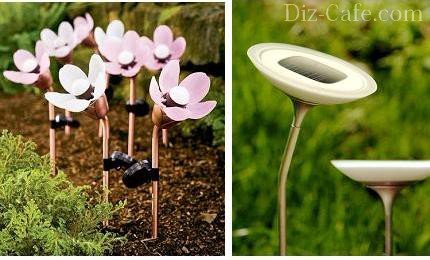
Artificial flowers in the form of solar-powered lamps will harmoniously fit into the landscape design of the garden
Festive decorative lighting of the site
Many owners of country cottages often spend non-standard decorative lighting on the eve of the holidays (New Year, Easter, March 8). To create a special atmosphere, you can use the following types of lamps:
Garlands
They can be completely wrapped around trees or used to stylize the facade: they can be placed over window openings, along the perimeter of the roof. For trees, garlands in the form of thin sticks with LEDs inside can also be used.

Grids with LEDs (a subspecies of modern garlands)
They can be fixed on flower beds, placed on the walls of the house.
Glowing figures
They represent a metal frame, supplemented by LEDs. Provides bright soft light, allowing you to illuminate a small area around you.There are also small figures (in the form of Christmas wreaths, flowers or flat silhouettes) that can be attached to the facade for festive lighting.

DIY lighting garden paths
Home »Lighting» Street lighting »DIY lighting garden paths
Twilight absorbs the beauty of any garden, making it scary and lifeless. However, competent illumination of garden paths can radically change the situation and give the garden a certain personality and security at night.
In this article, we will tell you how to make such a backlight, what to look for when choosing lamps and show you ready-made options.
DIY lighting garden paths: basic requirements
When organizing landscape lighting, it is necessary to rely on many factors, this will make it possible to make high-quality and complete lighting, which will not only be functional, but also very beautiful. If you can do all this, then this is the lighting of the garden paths of the photo, in the end you will succeed.
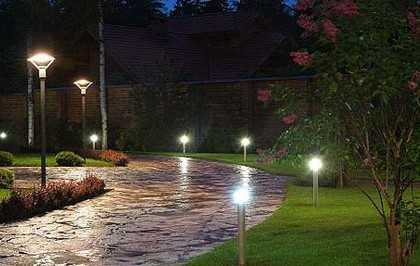
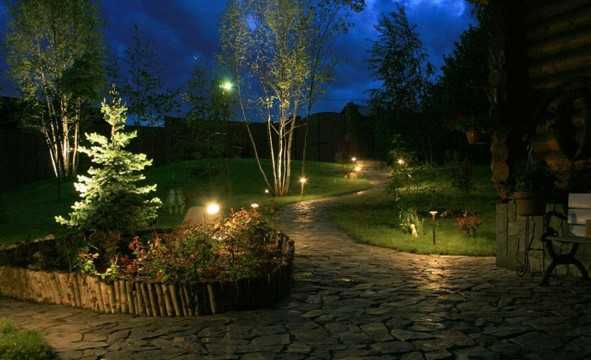
In order to avoid a mistake, the following principles must be observed:
- All lighting devices must work in all seasons and are not afraid of moisture and temperature extremes.
- Do-it-yourself lighting of garden paths should emit only soft light, which will create comfort and beauty.
- It is worth making a slightly different brightness of the lighting, the closer to the house - the higher it should be.
- It is optimal to highlight the edges of the paths, in this case the person will feel more confident walking along it.
Remember! There should not be too much light, otherwise the path will seem too ugly. The less light there is, the more mystery there will be, the options are presented above, this is the result it is worth trying to achieve.
What garden lights to use to illuminate the path
The choice of a lamp is the most important point, if you do everything right, then you can not be afraid of temperature drops and high humidity. Even under the harshest conditions, it should work fine. If we talk about color temperature, it all depends on you, we cannot recommend a specific option.
Classification of luminaires for illuminating the path:
- Incandescent lamps. The light output of such a device is only 15 lm / W, it will last several thousand hours, at a low cost, the option is excellent. But, the color temperature is too meager, the plafond will not radically change the situation.
- Halogen lamps. They resemble the first option in properties, only they serve several times longer.
- Fluorescent lamps, they must be taken with maximum protection. There is a significant disadvantage - at 0 degrees they fail almost immediately, so that they can be used only in the warm season.
- Sodium lamps emit orange or yellow light. They have the best luminous efficacy of 150-200 lm / W. The service life is about 30,000 hours.
- LEDs. They can be called the best option, you can easily find those that are not afraid of sub-zero temperatures and have all the protection indicators. The luminous flux is also varied.
Before installing lamps and lanterns for garden paths, you must draw the diagram yourself. It is necessary to correctly calculate and choose the distance in order to create optimal lighting. These are the schemes you should get.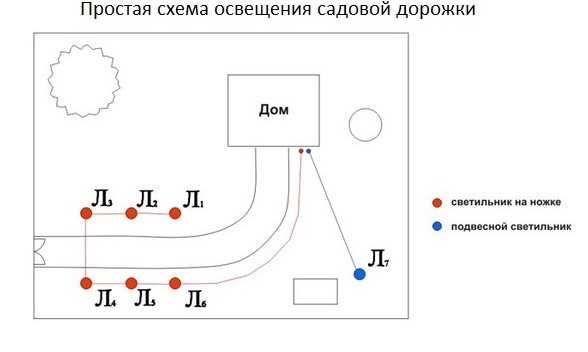

Lighting options
Garden lights in the form of stones
This method can only be used as decorative lighting. There is no special effort in the installation, you only need to show your imagination and nothing else. You can find stones of this type in any online store.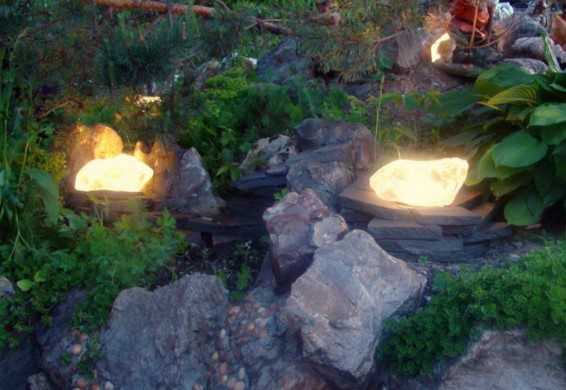
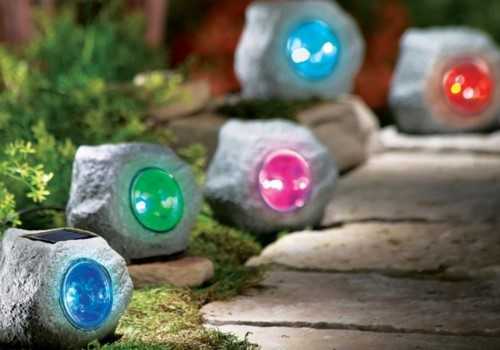

Watch another video.
Lanterns or lamps floor lamps
They are used as the main lighting for the garden. Most often, with the help of them, the illumination of garden paths is excellent. It is better to install it to illuminate the main road to the house.Also Read: Best Terrace Lighting Ideas.
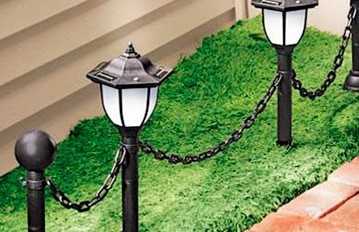
An important point! The light should shine only downward; it can get into the eyes of a person only if he bends over.
Marking lighting
Lamps of this type can be called "Bollard", in simple terms they can be designated as "Columns of light". They indicate only the direction of travel, it is optimal to install them on secondary droshky.
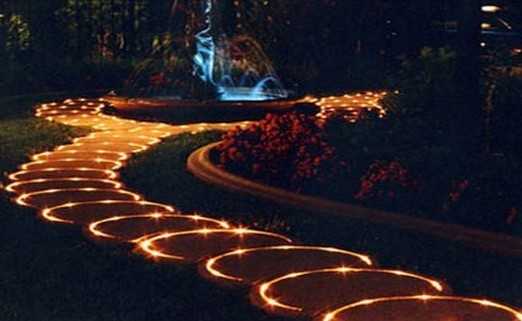
Solar powered lamps
The option is the simplest, you need to do:
- Buy.
- Poke it into the ground.
- Wait for the night.
That's all, but this method cannot be called good, if you do not have time and you want to save money, then this option will be great.
When choosing, we recommend paying attention to the manufacturer, Chinese, as a rule, serve one season
DIY lighting garden paths: video
It will be interesting to know: How to make lighting in a garage without electricity.
Self-installation diagram
If you are not afraid of physical work and are not new to the field of lighting fixtures and their maintenance, you can try to install the lighting fixtures yourself. At the first stage, you need to decide on the installation locations in order to calculate how much and what you need, and draw up a cabling scheme. The best place to illuminate garden paths is their borders (along parallel edges along the path), you can also lay lanterns in the middle. Often, paths around ponds and near gazebos are also illuminated.
Project preparation
After determining the place, it is necessary to draw up an action plan in order to organize the work as efficiently as possible:
- Develop a local lighting scheme.
- Select luminaires and decide on how to install them.
- Choose the best cable routing method.
- Make an estimate (calculation of materials).
- Prepare your work area.
- Install wiring and support posts (if needed).
- Connect devices and install monitoring devices.
Collection of components
In the process of work, you will need the following items and equipment:
- luminaires for outdoor lighting, which must be sealed, moisture resistant, resistant to climatic and weather changes, aesthetic;
- control equipment that helps automate the lighting system: motion sensors and rheostats to save energy;
- equipment for the installation of cables and conductors (terminals, wires, ties, pipes), which will combine all devices into one electricity transmission system.
Cabling
The cables are laid in two ways: above the ground and below it. Which one is best suited for your tracks depends on several factors: location of objects, installation time, cost.
It is safer and in some cases economically justified to involve professionals in the development of lighting and its installation. If you can easily find a suitable design in magazines, on the Internet, etc., then you definitely should not save on the services of an electrician.



